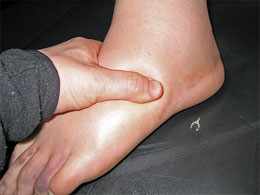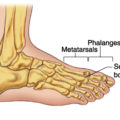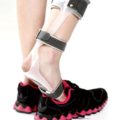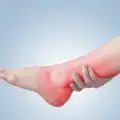*This page may contain affiliate links. When you buy through these links, we may earn a small commission at no extra cost to you.
Edema is the common term for swelling in any part of the body, which is accompanied by fluid retention in the body tissues.
This term is connoted for painless swelling, which may be either physiological or pathological.
Oedema is another common term used in place of edema in some countries.
Particularly there are two types of edema. These are:

- Pitting edema
- Non-pitting edema
There is an easy method to find out whether a person has pitting or non-pitting edema.
Press your thumb on the swollen area and hold it for 10 seconds. If a pit forms there then this is called the pitting edema.
If nothing forms and the skin come up as you remove your finger then it is called the non-pitting edema.
Generally, edema or swelling occurs in the legs, and particularly it affects the ankle and foot region.
Causes of Ankle Edema
Edema can be seen around the brain, around the eyes, arms, hands, legs, etc. However, foot and ankle edema is much more common.
Ankle edema swelling is often seen among people who are not much active. People who do not exercise or walk generally suffer from this problem due to a lack of physical activity.
If you travel for long (let’s say more than 4 hours), then due to the positional variance and regular sitting in one position – you may develop foot swelling or ankle edema.
Few other causes of swollen feet and ankles also include:
- Thyroid problems
- Arthritis
- Overweight
- Cirrhosis
- Pregnancy
- Menstruation and pre-menstruation
- Menopause
- Usage of contraceptive pills
- Organ failure
- Varicose veins
- Recent surgeries in the pelvic region
- Blockage in the lymphatic system
- Intake of certain medications like steroids, NSAIDs, etc.
Above are the main reasons for foot swelling in most of the people. Besides these, some of the pathological causes also include:
Renal disease:
This is one of the main reasons for the development of edema on the ankle.
This occurs because of the failure in the fluid retention, filtration, and elimination mechanism which leads to the excessive fluid retention in the body.
In 70% of the cases with edema due to the renal factor, there would be an associated cardiac factor also.
Cardiac disease:
When there is an extra workload on the heart, the pumping mechanism slows down.
This would lead to the increased pressure in the small blood vessels.
When the pressure in the small blood vessels and capillaries increase it would lead to the leakage of the fluid from the vessels.
This would, in turn, lead to the excess body fluid volume.
Due to the gravitational force, the fluid tends to get accumulated in the ankles and can cause swelling of feet or ankle edema.
It should be noted that in some pathological conditions the swelling may occur in only one leg which should be properly diagnosed and treated.
Symptoms of Ankle Edema
Ankle or foot edema symptoms may vary. These generally depend on the underlying causes. Few of the most common symptoms include:
- Swelling in the affected area
- Shiny, whitey and stretched skin
- Retaining of the skin dimple after the pressing for about 10 seconds
- Aching parts of the body and stiffness
- Puffiness around the ankle
- Weight gain or loss
- Increase in blood pressure or pulse rate
7 Best Treatment Methods For Swollen Feet And Ankles
What can be done at your home to treat the swelling in ankle and feet?
You would be glad to know that ankle edema pain can be relieved with some simple measures and treatments which can be taken at home without the need of taking medicines.
Some of the best treatment options that can be tried at home are:
1- Keeping your legs elevated

The first and foremost thing would be to keep the legs elevated whenever you sit down for any work or even while resting on bed.
While sleeping, a pillow or a leg rest can be kept below the legs to keep your feet elevated.
This would assist the blood flow towards the heart (against the gravity) and will help in easing feet swelling and pain caused.
2- Using foot bath with salt
Take a bucket (filled half level) with warm water. Now take two tablespoons of common salt (or Epsom salt) and mix it with it.
Wash your legs thoroughly and then immerse your legs in this hot water bucket.
The temperature of the water should be checked by the hands so that it is tolerable.
Now keep your legs for 10 minutes and remove it. This will help relieve the ankle edema problem fast.
In addition to this you can also consider massaging your feet slowly (using good essential oils) before going to bed which will help relax your feet overnight.
3- Wearing the best stockings and socks
Compression socks for ankle swelling is most of the time recommend for patients who suffer from this problem regularly.
As it helps to improve the circulation around the swollen area it effectively cures the problem of swollen feet faster and safer.
These medical socks for swollen feet can be purchased easily from a nearby pharmacy or from an online store such as Amazon.4- Lowering the consumption of salt
Excess salt is one of the main causes of swelling in feet.
Lowering down your salt intake and increasing fluid intake is therefore best natural home remedy for treating swollen feet and ankle.
This can help significantly to dilute the salt present in your body system thereby reducing the edema pain slowly by easily eliminating it from the system.
5- Get some magnesium supplements
Magnesium deficiency is a major reason which contributes to edema for many people.
Taking magnesium supplements can, therefore, help your get you some relief from edema pain.
You should talk to your doctor about the best recommendation and the dosage before taking these supplements.
Especially if you are suffering from swollen feet problems due to pregnancy you should keep a check on the dose you take daily.
6- Using pregnancy pillows

Swollen legs, feet and ankles is a common problem during pregnancy for most of the women.
Using the best pregnancy pillows is recommended most and should not be missed out in case you are suffering from ankle edema or foot swelling problem during pregnancy.
These full-body pillows are specially designed for providing the maximum comfort of the pregnant ladies.
These not only helps in relieving ankle pain from swollen feet but also helps in providing maximum comfort to other body parts such as belly, breasts, neck, back, etc.
7- Consider changing your medications
People who are suffering from a certain health condition (like high blood pressure and heart problems) and are taking medications are often found suffering from ankle edema due to these drugs.
If you feel that these drugs are the actual cause of your problem and it’s causing physical or emotional discomfort to you, its best to get an alternative prescription from your doctor.
In addition to above remedies, overweight people should include regular exercise or yoga plan in their schedule which will help in lowering down the weight and excess pressure on their feet which may be causing the swelling.
You can consider checking these best exercises and equipment for exercising your feet best.
Few Other Treatment Methods and Therapies
Other than the above home remedies for mild ankle edema there can particular treatment options such as Diuresis (taking diuretics) which can be used by your doctor after examining the specific cause of ankle edema.
Diuretics are the special types of drugs that enhance the production of urine in the kidney thus helping in the excretion of excess water (salt and fluids) from the body in different ways.
Care has to be taken that these drugs are not meant for pregnant patients or patients suffering from chronic venous insufficiency.
Besides the above treatment methods, your doctor may also recommend therapies such as Antiangiogenesis therapy, Oxygen therapy, and Lucentis for treating the edema or swelling problem in the ankles.
Incoming search terms:- medications that cause swollen feet
- how to treat ankle edema
- edema in feet and ankles






